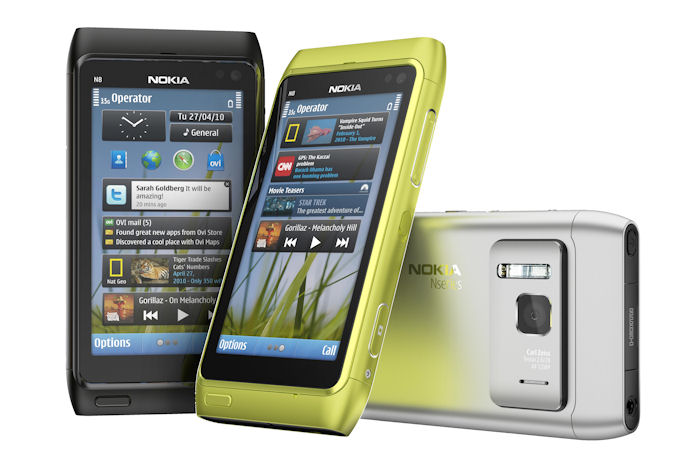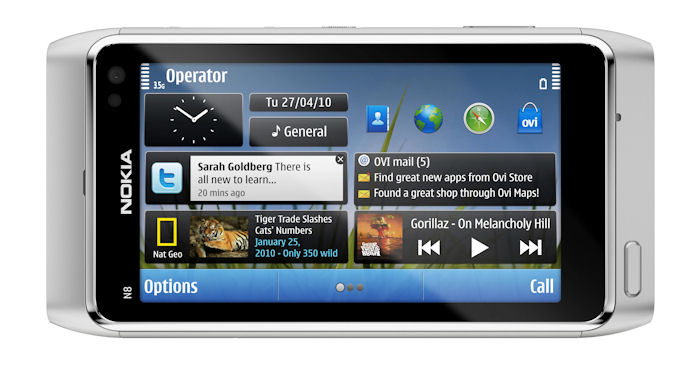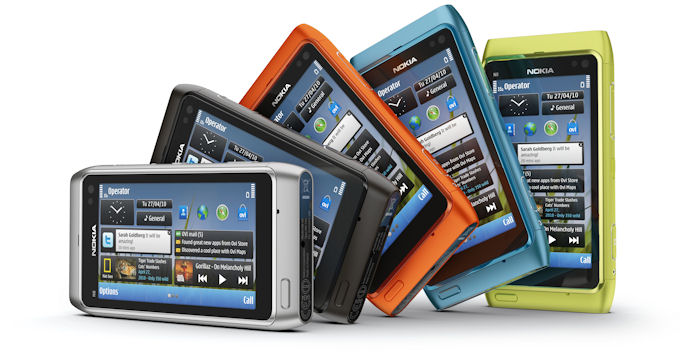The N8 marks a number of important firsts for Nokia: it is their first Symbian^3 device (latest version of the Symbian platform), their first 12 megapixel camera, their first HD video recording phone and their first phone using the new (third generation) hardware architecture (re-introducing a graphics co-processor).
A key promise of the Nokia N8 is HD video consumption and creation. The camera shoots 720p video at 25 frames per second, which can then be played back on the device (down-sized) or via the HDMI out port (using the supplied cable). Nokia is also introducing the Web TV service, which delivers content-on-demand from local and global TV favourites (e.g. CNN, E! Entertainment, Paramount and National Geographic; with additional 'channels' via Ovi Store). This content can also be played back via the HDMI out functionality, which includes support for Dolby Digital Plus Surround Sound. Together this ensures both high quality video and audio play back.
For what is clearly a high end specification it also breaks new ground on price. At €370 / £320 / $499 it will be significantly under cutting many devices with similar or higher specifications; consider that the Nokia N97 had a launch price of €550.

Key hardware features
- 113.5 x 59.12 x 12.9 in dimensions, 135g in weight; monoblock touch form-factor, with predominantly metal materials with some plastics (edges).
- 3.5 inch, OLED, capacitive screen; 640x 360 pixels resolution
- 12 megapixel camera with Carl Zeiss optics and Xenon flash; video recording at 720p resolution (1280×720) and 25 frames per second. Camera aperture of F2.8, focal length 5.4. Twin microphones for recording stereo audio in video
- Integrated A-GPS with location support for GPS, A-GPS, WLAN and Cell-ID.
- HDMI out (via Nokia Adapter Cable for HDMI CA-156), including support for Dolby Surround sound
- 3.5 mm Nokia AV connector for audio in/out and TV-out
- FM transmitter and FM Radio (with RDS)
- microUSB (USB 2.0) for file transfers, charging and USB On-the-Go (allows device to act as USB host e.g. plug USB memory sticks into it)
- BL-4D (1200mAh) Li-Ion battery, possibly non-removeable by user (awaiting confirmation)
- WCDMA 850/900/1700/1900/2100 and GSM/EDGE 850/900/1800/1900 (exact bands depend on market variant)
- WiFi; WLAN IEEE802.11 b/g/n and Bluetooth 3.0
- 135MB of internal memory, 16GB mass memory and microSD card slot (supports sizes upto 32 GB)
- 256 MB RAM; 512 MB ROM
- Processor listed on Forum Nokia as ARM 11 @ 680 Mhz with 3D Graphics HW Accelerator with OpenGL-ES 2.0 support (i.e. graphics co-processor).
- Initially available in five colours: Dark Grey, Silver White, Green, Blue and Orange
- Capacitive stylus for select markets (e.g. China to allow handwriting recognition).
- In box contents: Nokia N8 mobile computer, Nokia Battery BL-4D, Nokia Connectivity Cable CA-179, Nokia Stereo Headset WH-701, Nokia Compact Travel Charger AC-15, Nokia Adapter Cable for HDMI CA-156, Nokia Adapter Cable for USB OTG CA-157, Nokia Stylus SU-36 (selected markets only), Quick start guide

Key software features
- Runs Symbian^3
- Multi-page homescreen with fully customisable widgets (three pages, six widgets per page).
- Renewed music experience with cover flow albums
- Visual task switcher (see contents of application from the task switcher)
- Streamlined menu structure with fewer prompts (e.g. no connectivity prompts)
- Single tap 'Direct UI' paradigm (a change from the double tap Symbian^1)
- Symbian^3 contains very significant underlying changes including features such as writeable demand paging, which will greatly improve RAM memory usage.
- Flash Lite 4; with compatibility of Flash 10 for video codec and format support
- Ships with Ovi Maps (free car and pedestrian navigation in 70 countries and free premium travel guides), Nokia Messaging (both email and instant messaging), Ovi Music (music store) and Ovi Store (content store).

We'll be updating this and other stories through out the day.
Nokia's launch video
More videos can be found on Nokia's YouTube channel and on Nokia Conversations.
